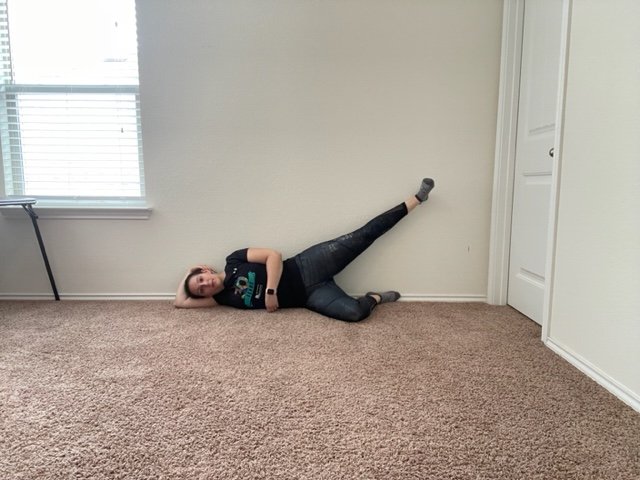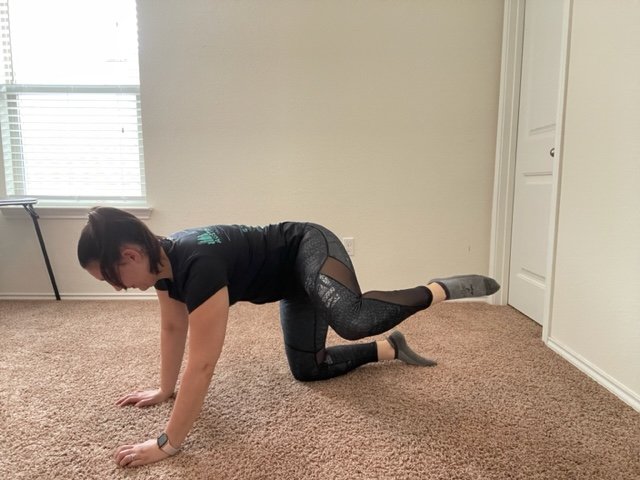Runners, don’t forget the gluteus medius
Running is a high intensity and high load activity which places demand on the lower body joints. After running, most people can feel the effects of the repetitive pounding on multiple joints- back, hips, knees, and ankles. Some people complain of general fatigue in the legs, others complain of joint soreness, some others tightness in the muscles. Ideally, decreasing the stress on lower body joints during running can help decrease risk of injury.
Attention to the hip external rotators such as the gluteus medius muscle can improve running form to decrease the effects of forces on the lower body joints. The gluteus medius muscle is a powerful hip external rotator and is also responsible for keeping the hips in alignment during stance. When the hip drops during stance, this causes increased valgus forces on the knee and contributes to overpronation of the ankle. If the gluteus medius muscle is strong and is activated prior to running, it can provide stability to the hip and support the knees and ankles. It is important to promote endurance strength to the gluteus medius in runners to decrease fatigue over time.
One study analyzed 19 triathlete’s running kinematics with different variables, placed them on a running gait retraining protocol, and determined which variables had a greater effect on risk of injury. The triathletes who had greater pelvic obliquity from R vs. L using 3D kinematics and weakness to gluteus medius contraction using sEMG resulted in higher risk of injury. While running prolonged distances, gluteus medius muscles fatigue over time and can cause the hip to drop with greater valgus stress on the knees resulting in impaired running gait pattern and a higher risk of injury.
One study analyzed 16 elite male triathlete’s running kinematics at the trunk, hips, knees, and ankles during a warm-up run vs. a transition run (the first 20 steps running immediately following cycling 90mins at race pace). The purpose of the study was to determine the differences in running kinematics of isolated running versus transition running of which triathletes typically feel less coordinated running off the bike. The running kinematics were measured using inertial motion capture (IMC) systems to gain continuous gait data on ground surfaces simulating a racing environment. Triathletes were significantly flexed more at the trunk, flexed at the hip during swing phase, greater hip internal rotation during stance, and more knee adduction at swing phase all during the transition run versus the warm-up run. Since gluteus medius is a strong hip external rotator, hip internal rotation in swing and stance can occur from decreased gluteus medius muscle activation or fatigue. In this study, it appears the incoordination of transition running could be influenced by decreased glute med muscle activation.
In general, don’t forget the gluteus medius when working on your strength training program. Perform at least one or a few glute med strengthening exercises during your training program. Include some of these exercises in a running or cycling warm up- prior to getting out the door or after a 5-10min easy spin or jog. Here are some general glute med strengthening exercises:
Clamshell resisted: take a resistance band around the knees, start with feet touching and knees touching in a bent knee position laying fully on your side. Raise knee up while rotating at the hip, keep your spine in alignment and do not rotate at the trunk (compensation). Repeat.
Plank Clamshell: start in a side-lying plank, raise hips and rotate knee up, then come back down. Repeat. Remember to keep your spine neutral in alignment.
Side-lying Straight Leg Raise (SLR) wall slide: position yourself against a free wall, align your heel up with the wall, slide the heel up the wall without rotating at the trunk, bring leg back down. Repeat. You can add a resistance band or ankle weight for greater force.
Bridging with resisted hip ABDuction: lay on your back with resistance band at the knees, perform a posterior pelvic tilt to engage the deep lower abdominals (transverse abdominus), squeeze glutes as you raise your hips up, spread knees apart keeping glutes engaged, hold for 5-10sec, bring knees together and return to start position. Repeat. You can perform this with both legs, or for a challenge straighten one leg out and perform hip abduction against band while in a bridge.
Firehydrant: Start in quadruped position on all fours, keep spine in neutral, rotate the leg out to the side as shown, repeat. You can add a band above the knees for greater resistance.
Resisted side steps or SLR: Shown above is SLR- keep your legs straight and extend the leg laterally while keeping spine neutral. Side steps: step together and out to the side, keep a slight bend in your knees.
Monster walks: with a slight bend in the knee, step forward and lateral at a diagonal and then step together, repeat. Then, perform in reverse stepping backward and lateral.
It is important to implement some of these strengthening exercises into your weekly strength routine. As an endurance athlete, you may want to increase the reps with lighter resistance and longer hold time (5-10seconds) to train the endurance muscle fibers to decrease fatigue over long duration running.
References:
Martínez-Gramage, Javier, et al. “A Random Forest Machine Learning Framework to Reduce Running Injuries in Young Triathletes.” Sensors, vol. 20, no. 21, MDPI, Nov. 2020, p. 6388. https://doi.org/10.3390/s20216388.
Fraeulin, Laura, et al. “Comparison of Joint Kinematics in Transition Running and Isolated Running in Elite Triathletes in Overground Conditions.” Sensors, vol. 21, no. 14, MDPI, July 2021, p. 4869. https://doi.org/10.3390/s21144869.
Baik, Seung Hyuk, et al. “Understanding and Exercise of Gluteus Medius Weakness: A Systematic Review.” Physical Therapy Korea, vol. 28, no. 1, Feb. 2021, pp. 27–35. https://doi.org/10.12674/ptk.2021.28.1.27.







